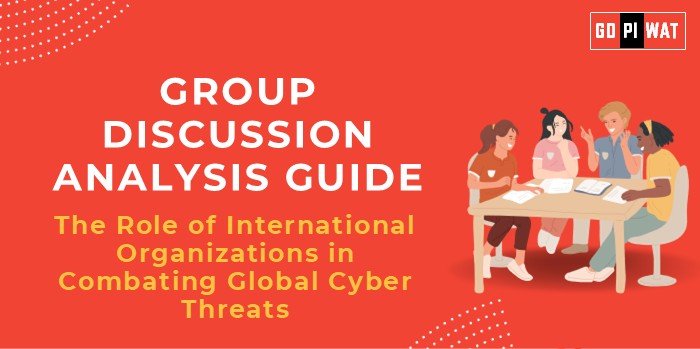📋 Group Discussion Analysis Guide
🌍 The Role of International Organizations in Combating Global Cyber Threats
💡 Introduction to the Topic
🌱 Opening Context: “In an increasingly digitized world, cyber threats transcend borders, targeting economies, infrastructure, and individuals. International organizations have emerged as pivotal players in orchestrating collaborative efforts to mitigate these risks.”
📜 Topic Background: Cyber threats have escalated due to rapid global digitization, with attacks on critical infrastructure, financial systems, and personal data breaches on the rise. Organizations like the United Nations (UN), INTERPOL, and the International Telecommunication Union (ITU) have mobilized member states to adopt frameworks for collective cybersecurity measures.
📊 Quick Facts and Key Statistics
- 💻 Global Cybercrime Costs: Projected to reach $8 trillion in 2023 (Cybersecurity Ventures).
- 👨💻 Cybersecurity Workforce Gap: 3.4 million unfilled positions globally (ISC²).
- 🎣 Phishing Attacks: Account for 36% of all data breaches (Verizon DBIR 2023).
- 🌐 UN Cybersecurity Frameworks: Over 100 member states collaborating on international cyber norms.
🌍 Stakeholders and Their Roles
- 🏛️ Governments: Establish national cybersecurity policies and facilitate international cooperation.
- 🏢 Private Sector: Develop innovative security solutions and share threat intelligence.
- 🌐 International Organizations: Standardize protocols and mediate cross-border collaboration.
- 👥 Civil Society: Advocate for digital rights and privacy.
🏆 Achievements and Challenges
🌟 Achievements:
- ✔️ Budapest Convention (2001): First international treaty on cybercrime adopted by 66 countries.
- 🤝 INTERPOL’s Global Cybercrime Strategy: Coordinated operations that dismantled cybercriminal networks.
- 🌍 Global Forum on Cyber Expertise (GFCE): Promotes capacity building in cybersecurity.
⚠️ Challenges:
- ⚖️ Fragmented Global Frameworks: Inconsistent regulations hinder cross-border enforcement.
- 🌐 Digital Divide: Limited cybersecurity capabilities in developing nations.
- 🤖 Rising Sophistication of Attacks: Emerging threats like AI-enabled cyberattacks.
🌍 Global Comparisons:
- ✅ Success: Estonia’s e-governance infrastructure effectively thwarted cyber threats post-2007 attacks.
- ❌ Challenge: The 2020 SolarWinds breach demonstrated vulnerabilities in even the most advanced systems.
📜 Case Study:
- 🌙 INTERPOL’s Operation Night Fury (2020): Disrupted a malware distribution network targeting financial institutions across ASEAN.
✨ Structured Arguments for Discussion
- 💬 Supporting Stance: “International organizations foster crucial dialogue and collaboration, preventing isolated responses to global threats.”
- ⚖️ Opposing Stance: “The absence of binding international cyber laws limits the effectiveness of current frameworks.”
- 🔄 Balanced Perspective: “While significant progress has been made, the complexity of cyber threats necessitates more agile and inclusive international cooperation.”
🎯 Effective Discussion Approaches
📖 Opening Approaches:
- 📊 “Cybercrime’s financial toll is projected to reach $8 trillion, underscoring the urgency of collective action.”
- 📜 “The Budapest Convention sets a precedent for international collaboration in combating cyber threats.”
🔄 Counter-Argument Handling:
- ✔️ “Acknowledge regulatory gaps but suggest adaptive frameworks like regional cyber agreements.”
📈 Strategic Analysis of Strengths and Weaknesses
- 💪 Strengths: Established networks for threat intelligence sharing; technical expertise from private and public sectors.
- ⚠️ Weaknesses: Regulatory inconsistency across regions; limited inclusion of developing nations.
- 💡 Opportunities: Use of AI for predictive threat analysis; expansion of public-private partnerships.
- 🚨 Threats: Growing sophistication of state-sponsored cyberattacks; proliferation of cybercriminal networks.
📚 Connecting with B-School Applications
- 🌟 Real-World Applications: Projects in cybersecurity frameworks or public-private partnership models.
- 💬 Sample Interview Questions:
- “How do you evaluate the effectiveness of international frameworks like the Budapest Convention?”
- “What role does the private sector play in global cybersecurity?”
- 📖 Insights for B-School Students:
- Focus on adaptive policymaking, innovation in cybersecurity technology, and leadership in collaborative initiatives.


